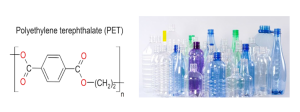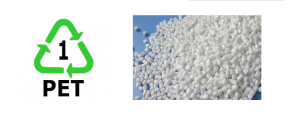Polyethylene terephthalate (sometimes written poly(ethylene terephthalate)), commonly abbreviated PET, PETE, or the obsolete PETP or PET-P, is the most common thermoplastic polymer resin of the polyester family and is used in fibres for clothing, containers for liquids and foods, thermoforming for manufacturing, and in combination with glass fibre for engineering resins.
The majority of the world’s PET production is for synthetic fibres (in excess of 60%), with bottle production accounting for about 30% of global demand. In the context of textile applications, PET is referred to by its common name, polyester, whereas the acronym PET is generally used in relation to packaging. Polyester makes up about 18% of world polymer production and is the fourth-most-produced polymer after polyethylene (PE), polypropylene (PP) and polyvinyl chloride (PVC).
PET consists of polymerized units of the monomer ethylene terephthalate, with repeating (C10H8O4) units. PET is commonly recycled, and has the number “1” as its resin identification code (RIC).

PET Copolymers
Polyethylene terephthalate is available as a Homopolymer and it can also be modified to produce copolymers (known as PETG or PET-G – polyethylene terephthalate glycol-modified) making it more desirable for a particular application.
The common modifiers which replace ethylene glycol or terephthalic acid to produce PETG are cyclohexane dimethanol (CHDM) and isophthalic acid respectively. There modifiers interfere with crystallization and lowers the polymer’s melting temperature.
Advantages & Key Properties of PET Resin
- It has higher strength
- It is very strong and lightweight & hence easy and efficient to transport
- It is known for its good gas (oxygen, carbon dioxide) and moisture barrier properties
- It exhibits excellent electrical insulating properties
- PET has broad range of use temperature, from -60 to 130°C
- As compared to PBT, it also has higher heat distortion temperature (HDT)
- It has low gas permeability, in particularly with carbon dioxide
- PET is suitable for transparent applications, when quenching during processing
- PET doesn’t not break or fracture. It is practically shatter-resistant and hence, a suitable glass-replacement in some applications
- It is recyclable and transparent to microwave radiation
- PET is approved as safe for contact with foods and beverages by the FDA, Health Canada, EFSA & other health agencies
Chemical Properties
- Excellent resistance to alcohols, aliphatic hydrocarbons, oils, greases and diluted acids
- Moderate resistance to diluted alkalis, aromatic & halogenated hydrocarbons
Limitations of Polyethylene Terephthalate
- Lower impact strength than PBT
- Lower moldability than PBT, due its slow crystallization rate
- Affected by boiling water
- Attacked by alkalis and strong bases
- Attacked at high temperatures (>60°C) by ketones, aromatic and chlorinated hydrocarbons and diluted acids and bases
- Poor burning behavior
Polyethylene Terephthalate Blends with Thermoplastics and Thermosets
Blending of PET with other thermoplastics or thermosets is done to tailor new materials having improved performance with beneficial cost profiles to meet specific application demands. Blending also opens up new markets and applications potential without much investment and development.
The thermoplastic polymers that are used to produce blends with PET are polyethylene, polypropylene, polycarbonates, polystyrene, ethyl vinyl acetate and Acrylonitrile Butadiene Styrene. And epoxies, polyester resins, phenolic resins, elastomers such as nitrile butadiene rubber, styrene butadiene rubber etc. are among thermosets which are used to produce in PET blends.

PET modified with polyolefins are often glass fiber reinforced and used in injection molded automotive and industrial applications- PET/PC blendsapplications include those requiring a combination of excellent toughness, chemical and heat resistance long with high impact, tensile and flexural strength
- Blending thermosets with PET significantly improves thermal, mechanical, impact resistance and flame retardant properties. These blends are mainly used for the production of automotive, aeronautic and electronic components
List of grades
[Homogeneous type]
| SA-1206 | 1.07 | High IV Low AA (acetaldehyde) |
Direct blow (small containers) |
| NEH-2070 | 0.88 | Low AA | Injection blow |
| NEH-2050 | 0.78 | Low AA | |
| NES-2040 | 0.72 | — | Injection blow Injection |
| MA-2103 | 0.68 | Opaque applications | Injection, extrusion |
| MA-2101M | 0.62 | High fluidity |
Copolymerization type and special grades]
| SA-863JP | 1.18 | Shock-resistant | Injection, extrusion |
| SA-8639P | 1.13 | Shock-resistant | |
| SA-8339P | 1.13 | Reduced drawdown High transparency |
|
| SA-1325P | 0.80 | Low AA | Injection blow |
| MA-8334P | 0.74 | High transparency | Injection, extrusion |
| MA-8633P | 0.68 | Shock-resistant | |
| MA-1340P | 0.57 | High fluidity | Injection |

Gamma Development Co. offers the most completive prices for this product. For receiving a quote please sends us your inquiry along with the LOI to our email :
export (@) gamma-co (.) ir
